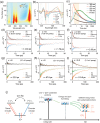Efficient Spin-Light-Emitting Diodes With Tunable Red to Near-Infrared Emission at Room Temperature
- PMID: 39887568
- PMCID: PMC11899487
- DOI: 10.1002/adma.202413669
Efficient Spin-Light-Emitting Diodes With Tunable Red to Near-Infrared Emission at Room Temperature
Abstract
Spin light-emitting diodes (spin-LEDs) are important for spin-based electronic circuits as they convert the carrier spin information to optical polarization. Recently, chiral-induced spin selectivity (CISS) has emerged as a new paradigm to enable spin-LED as it does not require any magnetic components and operates at room temperature. However, CISS-enabled spin-LED with tunable wavelengths ranging from red to near-infrared (NIR) has yet to be demonstrated. Here, chiral quasi-2D perovskites are developed to fabricate efficient spin-LEDs with tunable wavelengths from red to NIR region by tuning the halide composition. The optimized chiral perovskite films exhibit efficient circularly polarized luminescence from 675 to 788 nm, with a photoluminescence quantum yield (PLQY) exceeding 86% and a dissymmetry factor (glum) ranging from 8.5 × 10-3 to 2.6 × 10-2. More importantly, direct circularly polarized electroluminescence (CPEL) is achieved at room temperature in spin-LEDs. This work demonstrated efficient red and NIR spin-LEDs with the highest external quantum efficiency (EQE) reaching 12.4% and the electroluminescence (EL) dissymmetry factors (gEL) ranging from 3.7 × 10-3 to 1.48 × 10-2 at room temperature. The composition-dependent CPEL performance is further attributed to the prolonged spin lifetime as revealed by ultrafast transient absorption spectroscopy.
Keywords: chiral perovskite; circularly polarized electroluminescence; red and NIR‐LED; spin funneling; spin‐LED.
© 2025 The Author(s). Advanced Materials published by Wiley‐VCH GmbH.
Conflict of interest statement
The authors declare no conflict of interest.
Figures




Similar articles
-
Efficient Green Spin Light-Emitting Diodes Enabled by Ultrafast Energy- and Spin-Funneling in Chiral Perovskites.J Am Chem Soc. 2024 May 22;146(20):14157-14165. doi: 10.1021/jacs.4c02821. Epub 2024 May 10. J Am Chem Soc. 2024. PMID: 38727602
-
Efficient Red-Emissive Circularly Polarized Electroluminescence Enabled by Quasi-2D Perovskite with Chiral Spacer Cation.ACS Nano. 2023 Apr 25;17(8):7830-7836. doi: 10.1021/acsnano.3c01054. Epub 2023 Apr 11. ACS Nano. 2023. PMID: 37039626
-
Spin Quantum Dot Light-Emitting Diodes Enabled by 2D Chiral Perovskite with Spin-Dependent Carrier Transport.Adv Mater. 2024 Feb;36(5):e2305604. doi: 10.1002/adma.202305604. Epub 2023 Dec 5. Adv Mater. 2024. PMID: 37789724
-
Circularly Polarized Organic Light-Emitting Diode Based on Device Functional Layer Materials.Small. 2025 Feb;21(8):e2409541. doi: 10.1002/smll.202409541. Epub 2025 Jan 31. Small. 2025. PMID: 39887943 Review.
-
Chirality-Induced Spin Selectivity in Hybrid Organic-Inorganic Perovskite Semiconductors.Annu Rev Phys Chem. 2025 Apr;76(1):519-537. doi: 10.1146/annurev-physchem-082423-032933. Epub 2025 Feb 14. Annu Rev Phys Chem. 2025. PMID: 39952641 Review.
References
-
- Cho H., Jeong S. H., Park M. H., Y. H., Kim C. W., Lee C. L., Heo J. H., Sadhanala A., Myoung N., Yoo S., Im S. H., Friend R. H., Lee T. W., Nature 2015, 350, 6265. - PubMed
-
- Tan Z. K., Moghaddam R. S., Lai M. L., Docampo P., Higler R., Deschler F., Price M., Sadhanala A., Pazos L. M., Credgington D., Hanusch F., Bein T., Snaith H. J., Friend R. H., Nat. Nanotechnol. 2014, 9, 687. - PubMed
-
- Quan L. N., Rand B. P., Friend R. H., Mhaisalkar S. G., Lee T. W., Sargent E. H., Chem. Rev. 2019, 119, 7444. - PubMed
-
- Liu X. K., Xu W., Bai S., Jin Y., Wang J., Friend R. H., Gao F., Nat. Mater. 2021, 20, 10. - PubMed
-
- Gong S., Qu G., Qiao Y., Wen Y., Huang Y., Cai S., Zhang L., Jiang K., Liu S., Lin M., Beard M. C., Xu Z.‐X., Chen X., Energy Environ. Sci. 2024, 17, 5080.
Grants and funding
LinkOut - more resources
Full Text Sources
Miscellaneous

